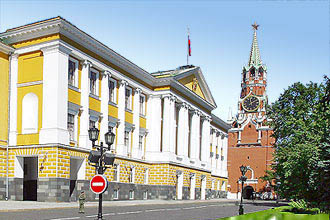 |
 The Senate Building is comparatively young, its construction dating from 1776-1788. Architect Matvei Kazakov designed it in the style known as Moscow Classical. Unencumbered by the limited space, the great draughtsman managed to create a genuine architectural masterpiece. The triangular exterior surrounds a large courtyard divided into three parts, and the Senate attains a perfect harmony with the other Kremlin buildings around it. The Senate's facades are marked by the spirit of early classicism, and have little superfluous decoration.
Particularly interesting is the famous circular hall of the Senate, which connoisseurs of architecture have dubbed the Russian Pantheon. This hall-cum-rotunda has a diameter of almost 25 meters, and is an incredible 27 meters high. Imposing colonnades run round the perimeter of the space, and it is topped by a dome containing 24 windows. Sculptured bas-reliefs fill the space between the columns and the windows.
The Senate Building is comparatively young, its construction dating from 1776-1788. Architect Matvei Kazakov designed it in the style known as Moscow Classical. Unencumbered by the limited space, the great draughtsman managed to create a genuine architectural masterpiece. The triangular exterior surrounds a large courtyard divided into three parts, and the Senate attains a perfect harmony with the other Kremlin buildings around it. The Senate's facades are marked by the spirit of early classicism, and have little superfluous decoration.
Particularly interesting is the famous circular hall of the Senate, which connoisseurs of architecture have dubbed the Russian Pantheon. This hall-cum-rotunda has a diameter of almost 25 meters, and is an incredible 27 meters high. Imposing colonnades run round the perimeter of the space, and it is topped by a dome containing 24 windows. Sculptured bas-reliefs fill the space between the columns and the windows.
After the 1917 revolution, the building was used by the Soviet Government for meetings of the USSR Council of Ministers, and also contained the private study used by both Lenin and Stalin, under which a secret passage was later discovered and, it is speculated, may have been used by Beria to listen in on confidential conversations. The building has, since 1991, been the official residence of the President of the Russian Federation.
|
 |

 The Senate Building is comparatively young, its construction dating from 1776-1788. Architect Matvei Kazakov designed it in the style known as Moscow Classical. Unencumbered by the limited space, the great draughtsman managed to create a genuine architectural masterpiece. The triangular exterior surrounds a large courtyard divided into three parts, and the Senate attains a perfect harmony with the other Kremlin buildings around it. The Senate's facades are marked by the spirit of early classicism, and have little superfluous decoration.
Particularly interesting is the famous circular hall of the Senate, which connoisseurs of architecture have dubbed the Russian Pantheon. This hall-cum-rotunda has a diameter of almost 25 meters, and is an incredible 27 meters high. Imposing colonnades run round the perimeter of the space, and it is topped by a dome containing 24 windows. Sculptured bas-reliefs fill the space between the columns and the windows.
The Senate Building is comparatively young, its construction dating from 1776-1788. Architect Matvei Kazakov designed it in the style known as Moscow Classical. Unencumbered by the limited space, the great draughtsman managed to create a genuine architectural masterpiece. The triangular exterior surrounds a large courtyard divided into three parts, and the Senate attains a perfect harmony with the other Kremlin buildings around it. The Senate's facades are marked by the spirit of early classicism, and have little superfluous decoration.
Particularly interesting is the famous circular hall of the Senate, which connoisseurs of architecture have dubbed the Russian Pantheon. This hall-cum-rotunda has a diameter of almost 25 meters, and is an incredible 27 meters high. Imposing colonnades run round the perimeter of the space, and it is topped by a dome containing 24 windows. Sculptured bas-reliefs fill the space between the columns and the windows.